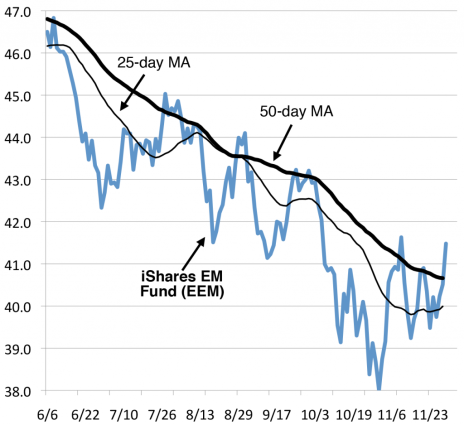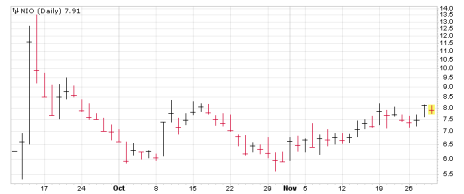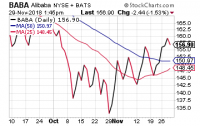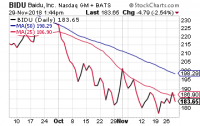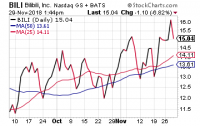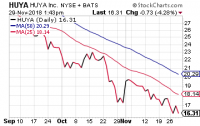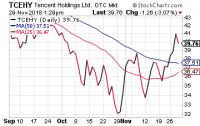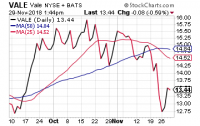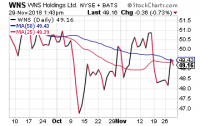Well, things are looking up in the emerging markets world! The Cabot Emerging Markets Timer has given us a new buy signal and we’re taking advantage by moving two stocks from the Watch column, one from the Hold column and one brand new stock all to Buy ratings. All told, it’s an early holiday present for all of us. Read on for details of the good news!
Cabot Emerging Markets Investor 673
[premium_html_toc post_id="165184"]
Cabot Emerging Markets Timer
The Emerging Markets Timer is our disciplined method for staying on the right side of the emerging markets. The Timer is bullish when the index is above the lower of its two moving averages and that moving average is trending up.
Our Emerging Markets Timer has flashed a new buy signal, a sign that, for the first time in months, the intermediate-term trend is turning up. You can see that the iShares EM Fund (EEM) hit a low in late October with all other global markets, but thrust higher from there and, in November, held its ground. Now the fund is perking up again, with its lower (25-day) moving average turning up.
That doesn’t mean you should throw caution to the wind—we like to slowly come off the sideline in these situations, and if the sellers reappear, quickly step back. But right now, the evidence has improved enough to put some money back to work.
That May Leave a Mark
While Chinese stocks haven’t exactly been scampering up the charts, there’s a growing sense that the late-October lows put in by the Golden Dragon ETF (PGJ) may be the start of a basing process. PGJ found firm support at 31.5 in the last week of October, then rallied to 36 in early November. And the ETF has been trading in a tightening range ever since.
That combination of holding above a low and making a series of higher lows and lower highs is one of those technical chart patterns that suggest a lot but don’t explicitly say anything. The more useful pattern is for the ETF to break out above its previous resistance and move to new multi-month highs.
The meaningful measure that I look at in making investment decisions is the relationship between the MSCI Emerging Markets ETF (EEM) and its 25- and 50-day moving averages. And EEM is now hovering above its lower (25-day) moving average, and that average is trending up, which means we have a new buy signal.
It’s important to take notice that this hopeful action in Chinese and emerging market stocks is happening even while the U.S. president is threatening higher tariffs on Chinese goods and Chinese diplomats are forecasting dire consequences.
The G-20 summit in Buenos Aires will be closely watched as Trump and Xi Jinping meet face to face on Saturday. Many observers (including, apparently, most investors) see signs that both leaders want to reach an agreement to lower the temperature of the trade war. Even the U.S. president’s chief economic advisor has said that “there’s a good possibility that we can make a deal,” and it’s that optimism that’s reflected in the modest strength of the Chinese and emerging-market ETFs.
Our portfolio has been heavily in cash for a long time, and I’m as eager as anyone to get back in the business of buying stocks. But that will only happen if the Cabot Emerging Markets Timer flashes a continuing green light, and even then, only one stock at a time as I let the market pull us slowly back in.
Moving on, I have just a word about the headlines that announced the revelation that Jack Ma, the founder of Alibaba and a very very rich man, was actually a member of the Communist Party of China.
The word is, “duh.”
Party membership has usually been regarded as a necessary step to advancement in China, at least for any government positions. And while about a third of China’s entrepreneurial class is estimated to be Party affiliated, Alibaba had been pretty coy about its Chairman.
The real story here is that CCP actually did the revealing of Ma’s membership, presumably as a way to reinforce the prestige and power of the Party itself.
The implications of having Jack Ma outed as a Party member are pretty slim. Investors who want to own Chinese stocks have long ago made their peace with the whole issue of Communism. And the fact is that the CCP is small-c “communist” in a way that Marx would hardly recognize. At the present time, the Party is about 90% a garden-variety oligarchy with autocratic tendencies.
As always, any decisions that Cabot Emerging Markets Investor makes about investments in China or any other part of the world will be made on the basis of Story, Numbers and Charts. Political ideology won’t enter into it.
Featured Stock
The Tesla of China ... Maybe
NIO Inc. (NIO)
China is the largest automobile market in the world, and the country has a thriving group of domestic manufacturers to meet demand. But foreign brands have largely owned the top prestige spots, with Mercedes Benz, Audi, Range Rover and other international marques in the lead for bragging rights among Chinese drivers.
NIO, a Chinese designer and manufacturer of electric cars, including self-driving cars, means to change that.
Calling itself a “next-generation car company,” NIO has been following a familiar formula for aspirants to high-end success. The company has developed an electric supercar, the EP9, which has set speed records for fastest lap times (without a driver) at U.S. and European tracks. The EP9 accelerates from zero to 124 MPH in 7.1 seconds and has a top speed of 194 MPH. NIO’s racing teams have won driver’s championships in the new Formula E class. It’s a great headline builder, but it’s not a street-legal ride and production is extremely limited.
In 2017, with the EP9 leading the publicity charge, NIO started selling its first production car, the NIO ES8, a seven-seater electric SUV with an onboard pilot system, an autonomous driving assistance system and what it calls “the first in-car intelligent AI system.” With a three-row leather interior, and a ton of special features, the ES8 is aimed squarely at the Tesla-level customer—it has a base price of about $64,500, with a “founder’s edition” going for around $79,000.
The ES8 has some battery charging features that sound interesting, including a battery rental plan and a three-minute battery swap. For drivers who don’t want being in a car to interrupt their shopping experience, NIO has arrangements with JD.com and SF Express for in-car delivery.
NIO released its third-quarter results on November 6, and revenue results were strong, but hard to read, since it was just the company’s second quarter with any revenue at all. The company reported $6.9 million in sales in Q2, so Q3’s $214 million represented more than a 3,000% increase. Moreover, the Q4 outlook was solid, with management expecting ES8 deliveries to total nearly 7,000 (up 110% or so from last year) and total revenues to also roughly double, at least in local currency terms.
That said, Q3 earnings came in at a loss of 39 cents per share, which about doubled the loss for Q3 2017. The expenses of actually manufacturing and delivering a car took a toll there. And while analysts expect the 2019 loss to shrink by 76%, profits are still a ways out in the future.
NIO Inc. is an interesting concept. Where Tesla designs, manufactures and delivers its own cars, NIO sources the components of the ES8 from many vendors. This reduces costs, helping the company with its commitment to produce a Tesla-quality car at prices lower than Tesla’s.
Speaking of Tesla, since NIO and its ES8 are aimed directly at the U.S. electric car giant, the recent tariff wars between the U.S. and China have had a huge effect on Elon Musk’s Chinese plans. Tesla’s factory in Shanghai is still idle, and the company’s sales in China were down by 70% in October. That’s a huge opportunity for NIO Inc., as total electric vehicle sales in China were up 85% year-over-year. As NIO Inc.’s factory ramps up its capacity, its backlog of reservations for ES8’s stands at 15,800. It’s a good sign.
NIO stock came public just 11 weeks ago, leaping from 6 at the open on September 12 to a high near 13 on September 13. But the next few weeks pulled the stock right back to its IPO price, and there hasn’t been a ton of movement since the stock bounced back to 8 in mid-October, with NIO back to 6 in late October and up again near 8 in recent trading.
In short, it looks like NIO has done much of the grunt work of establishing a reasonable post-IPO base, with support at 6 and resistance at 8. Despite the new buy signal from the Cabot Emerging Markets Timer, we still think it’s a bit too early to jump in on NIO. We’d like to see emerging market and Chinese stocks spend a little more time in positive territory and for NIO to rally above 8.5 before we do any buying.
NIO is a brand new issue, with only scant sponsorship by the investment giants who may take a little more time and research before getting comfortable buying in size. The potential market for the company’s cars is enormous and their one product is attractive. WATCH.
NIO Inc. (NIO)
Building 20
No. 56 AnTuo Road Jiading District
Shanghai 201804
China
86 21 6908 3306
http://www.nio.io
Model Portfolio
Invested 40% Cash 60%
Updates
After months in the doldrums, our Emerging Markets Timer has turned bullish, which is obviously encouraging. We’re not shouting from the rooftops, as the longer-term trend is still clearly in question, but there’s no question the evidence has improved during the past few weeks.
So what should do you? Do some buying, but go relatively slow. As markets get volatile, most investors have the urge to make major moves—their ego pushes them toward doing a ton of buying or selling all at once. While that can occasionally be the right move, our experience tells us that stepping in slowly works better. If the rally fizzles, you won’t have much exposure, and if the upmove accelerates, it won’t take us long to get heavily invested given that we run a concentrated portfolio.
Tonight, we’re going to add a full position in Bilibili (BILI) and a half position in Tencent (TCEHY), along with a half position in NIO, our recommendation in this issue. We’re also placing Alibaba (BABA) back on Buy a Half.
Alibaba (BABA) has been showing relative strength since early October, and the stock has now lived above its 50-day line for most of the past week, the first time that’s happened since June. There’s still overhead to chew through, of course, and we’d like to see a bit more upside volume come into the stock. But BABA remains a Chinese blue chip, and if this rally gets legs, we think investors could look ahead to the firm’s reaccelerating earnings growth (30% next year). We’ll go back to a Buy rating for a half-sized position. BUY A HALF.
Baidu (BIDU) is still looking like an egg, unable to bounce, probably due to the firm’s decelerating sales growth (36%, 27% and 11% over the past three quarters) and mundane earnings estimates (up 11% in 2019). We’ll watch it a bit longer, as sometimes these big stocks need a few days to get going. But the longer it’s unable to bounce, the greater the chance it won’t be a leader of the next advance (or worse, will hit new lows going forward). WATCH.
Bilibili (BILI) is now rated Buy, given months of encouraging action (higher lows since the summer, despite the meltdown in Chinese stocks), a positive reaction to earnings last week, and another minor new high yesterday. Back to the earnings for a minute, revenues grew 48% in local currency terms, while monthly active users lifted 25% (mobile users up 33%) and paying users boomed 202% to 3.5 million. The guidance was solid, too, and while the bottom line is still in the red, that could change if BILI tops estimates going forward. Like every other EM stock, BILI isn’t free and clear, but it is hitting its highest levels since June, which is a rarity. You can take a position here. BUY.
Huya Inc. (HUYA) looks like another egg, with neither earnings (out a couple of weeks ago) or the recent market bump bringing in the buyers. In fact, the stock just hit a new low on Tuesday! Like BIDU, there’s no harm in keeping it on the watch list another week or two and seeing if it can kick into gear should the market’s rally gain steam. WATCH.
MiX Telematics (MIXT) continues to act just fine, holding in a tight-ish range (17 to 18.5) following its post-earnings ramp (13.5 to 19) a month ago. We’re more than willing to fill out our position (buying another half-sized stake), but would prefer to do so a point or two higher, when we have a decent profit. Thus, if you own some, just sit tight for now; if you’re not yet in, we’re fine starting a position here and (hopefully) buying more should the stock and market rise. BUY A HALF.
Petrobras (PBR) remains a Hold, as the energy sector continues to cap the stock’s upside for now. But relative to its peers, PBR is actually resilient (still holding near its 50-day line, and fundamentally, the company’s unique story continues to play out—the firm agreed to sell three dozen shallow-water and onshore oil fields to a couple of suitors for a total of $823 million, and reported that its output in October rose 8% from the prior month. We advise you to hang on to your half position, though a drop toward 13 would likely have us cutting bait. HOLD A HALF.
Tencent (TCEHY) looks a lot like BABA, which isn’t surprising, as these blue-chip Internet plays tend to swim together. Yes, growth has slowed, and earnings estimates call for relatively modest gains (17%) in 2019. But it’s certainly possible that the stock’s near-50% decline has discounted the slowdown we’re seeing, and there’s no question that the firm has enough irons in the fire to get going again on the upside. (The firm announced a deal this week to enter the mobile payments market in Japan.) Long story short, with the new green light from market timing, we’ll add a half position in TCEHY here. BUY A HALF.
Vale (VALE) has been caught in push-pull of the trade war fears, plunging to new lows as iron ore futures in China fell sharply earlier this week, before bouncing on Tuesday and Wednesday. VALE isn’t looking great, but our loss is reasonable, and we want to see how the stock acts from here. We will, however, switch our rating to Hold given the damage, and use a tight stop near this week’s lows. HOLD.
WNS Holdings (WNS) doesn’t look bad and remains worth watching, but it’s not strong enough for a Buy rating despite the improvement from market timing. We think the steadiness of the firm’s business should eventually lead to another leg up, but we prefer to wait for a push above resistance near 51.5 before jumping in. WATCH.
[premium_html_footer]
Send questions or comments to paul@cabotwealth.com.
Cabot Emerging Markets Investor • 176 North Street, Salem, MA 01970 • www.cabotwealth.com
All Cabot Emerging Markets Investor buy and sell recommendations are made in issues or updates and posted on the Cabot subscribers’ website. Sell recommendations may also be sent to subscribers as special alerts via email. To calculate the performance of the hypothetical portfolio, Cabot “buys” and “sells” at the midpoint of the high and low prices of the stock on the day following the recommendation. Cabot’s policy is to sell any stock that shows a loss of 20% in a bull market (15% in a bear market) from our original buy price, calculated using the current closing (not intra-day) price. Subscribers should apply loss limits based on their own personal purchase prices.
THE NEXT CABOT EMERGING MARKETS INVESTOR ISSUE IS SCHEDULED FOR December 13, 2018
We appreciate your feedback on this issue. Follow the link below to complete our subscriber satisfaction survey: Go to: www.surveymonkey.com/chinasurvey
Cabot Emerging Markets Investor is published by Cabot Wealth Network, an independent publisher of investment advice since 1970. Neither Cabot Wealth Network, nor our employees, are compensated in any way by the companies whose stocks we recommend. Sources of information are believed to be reliable, but they are in no way guaranteed to be complete or without error. Recommendations, opinions or suggestions are given with the understanding that subscribers acting on information assume all risks involved. © Cabot Wealth Network 2018. Copying and/or electronic transmission of this report is a violation of the copyright law. For the protection of our subscribers, if copyright laws are violated, the subscription will be terminated. To subscribe or for information on our privacy policy, visit www.cabotwealth.com, write to support@cabotwealth.com or call 978-745-5532.
[/premium_html_footer]



